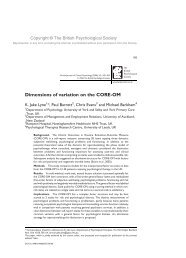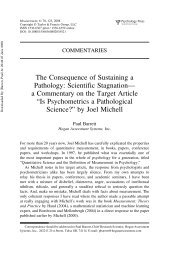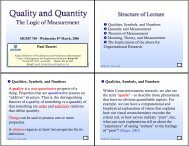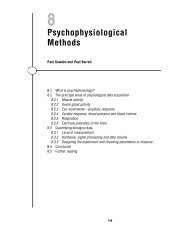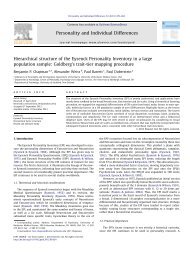Counselling Psychology Review - Paul Barrett
Counselling Psychology Review - Paul Barrett
Counselling Psychology Review - Paul Barrett
You also want an ePaper? Increase the reach of your titles
YUMPU automatically turns print PDFs into web optimized ePapers that Google loves.
Dr Miodrag Popovic, Dr D. Milne & Professor P. <strong>Barrett</strong><br />
options sometimes appears incomplete with<br />
a positive bias (see Larsen et al., 1979) that<br />
could only result in the ‘skewed’ picture.<br />
The new questionnaire aims to improve<br />
its relevance for clients by involving them in<br />
its design, to increase the usefulness of data<br />
and response rate by offering a simple multichoice<br />
response set, episode-specific and<br />
open-ended questions/comments and to<br />
incorporate more recent findings about the<br />
relevant surveys and ongoing service change.<br />
Method<br />
Preliminary/Qualitative investigations<br />
A comprehensive, 37-item satisfaction survey<br />
questionnaire, developed by colleagues<br />
(1990, unpublished) at the Department, was<br />
used as the starting point in developing the<br />
new questionnaire. Many relevant changes<br />
of this outdated questionnaire (and the item<br />
pool of 60 questions) took place, including<br />
an increase in the questions’ discriminative<br />
power by using a five-point scale. Eight questions<br />
were excluded (e.g. two for concerning<br />
GPs’ rather than the Department’s Service,<br />
two for being repetitious with a different<br />
scale), some modified, and several new ones,<br />
as well as place for comments were added.<br />
Squier’s (1994) Client Satisfaction Survey<br />
Questionnaire was consulted and the new<br />
measure became organised into sections and<br />
subsections, with a fourth section (‘general<br />
satisfaction’) being added. Several questions<br />
concerning therapeutic relationship and<br />
outcome from Squier’s (1994) questionnaire<br />
were shortened and changed to a five-point<br />
scale response format; the term ‘clinical<br />
psychologist’ was replaced by ‘therapist’, to<br />
accommodate various helping professionals<br />
(e.g. psychologists, counsellors). One question<br />
was adapted (‘counsellor’ to ‘therapist’)<br />
and another modified (from asking directly<br />
to asking indirectly) versions of two questions<br />
from Damkot et al. (1983) Client Satisfaction<br />
Survey Questionnaire. Furthermore,<br />
two questions, one from the Service Evaluation<br />
Questionnaire (Blakey, Sinclair &<br />
Taylor, 1994) and another from Larsen et al.<br />
(1979) Client Satisfaction Scale, were shortened<br />
and changed to a five-point scale<br />
response format.<br />
The newly-developed questions particularly<br />
aimed to elicit more information about<br />
clients’ background/socio-demographic data,<br />
appointments, the type of therapist (e.g.<br />
counsellors) and to accommodate new,<br />
specific circumstances (e.g. providing information<br />
on nature of therapy).<br />
Investigations of the likely acceptability of<br />
the new questionnaire were undertaken<br />
using several professional and administrative<br />
colleagues. To ensure face and content validity,<br />
the early versions of the questionnaire were<br />
tested, investigated and discussed with a<br />
range of ‘experts’ (five clients/outpatientvolunteers,<br />
two ex-clients, five counsellors,<br />
four clinical psychologists, one clinical/<br />
counselling psychologist, one counselling<br />
psychologist-trainee, administrative manager,<br />
the Chief Officer of the local Community<br />
Health Council, a statistician and an university<br />
lecturer), resulting in various changes.<br />
Main study<br />
Participants<br />
The target, main (test-retest) participant group<br />
came from the AMH clients. Sixty-one clients<br />
consented, completed and returned the<br />
questionnaire at Time 1. Subsequently, 45 of<br />
them returned a second questionnaire at<br />
Time 2. They were all clients of the participating<br />
therapists (three counsellors, one<br />
clinical psychologist, one clinical/counselling<br />
psychologist, one counselling<br />
psychologist-trainee), with the selection of<br />
therapist-participants being dictated by the<br />
employment situation. The inclusion criterion<br />
for clients was frequency of appointment<br />
(i.e. only those seen on a weekly or a<br />
fortnightly basis); the exclusion criterion was<br />
clients presenting with acute or psychotictype<br />
crisis (no such clients were reported).<br />
Measure<br />
The first two (‘auxiliary’) sections of the new<br />
questionnaire concern basic background<br />
information of clients, health status, the type<br />
of therapist they saw and their appointments<br />
18 <strong>Counselling</strong> <strong>Psychology</strong> <strong>Review</strong>, Vol. 22, No. 2, May 2007



